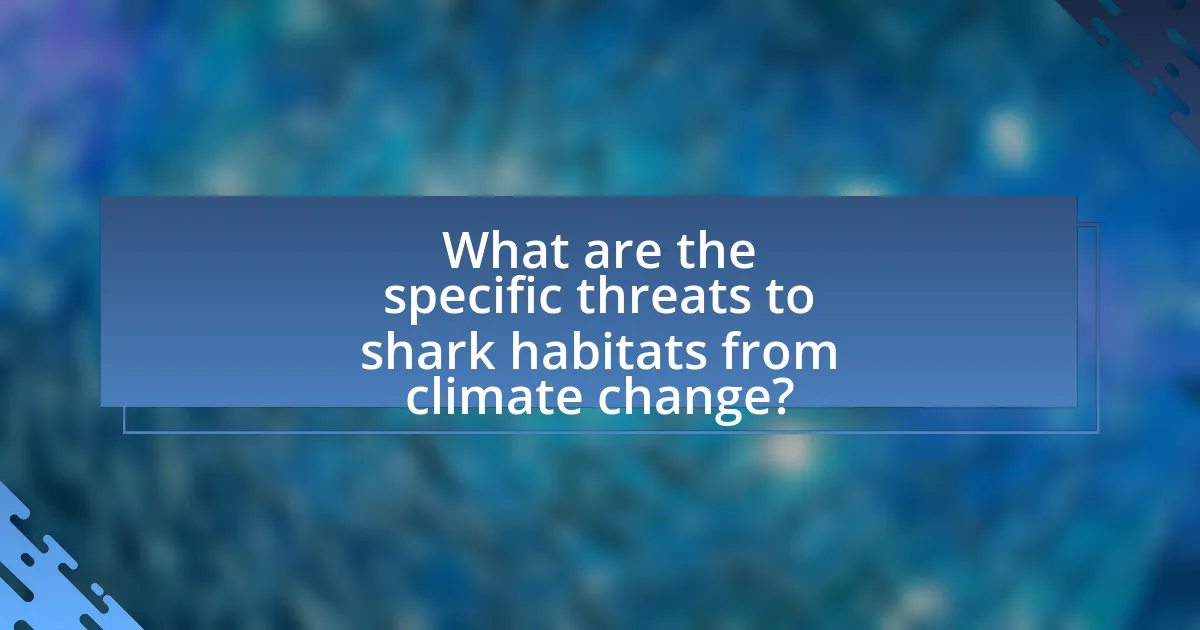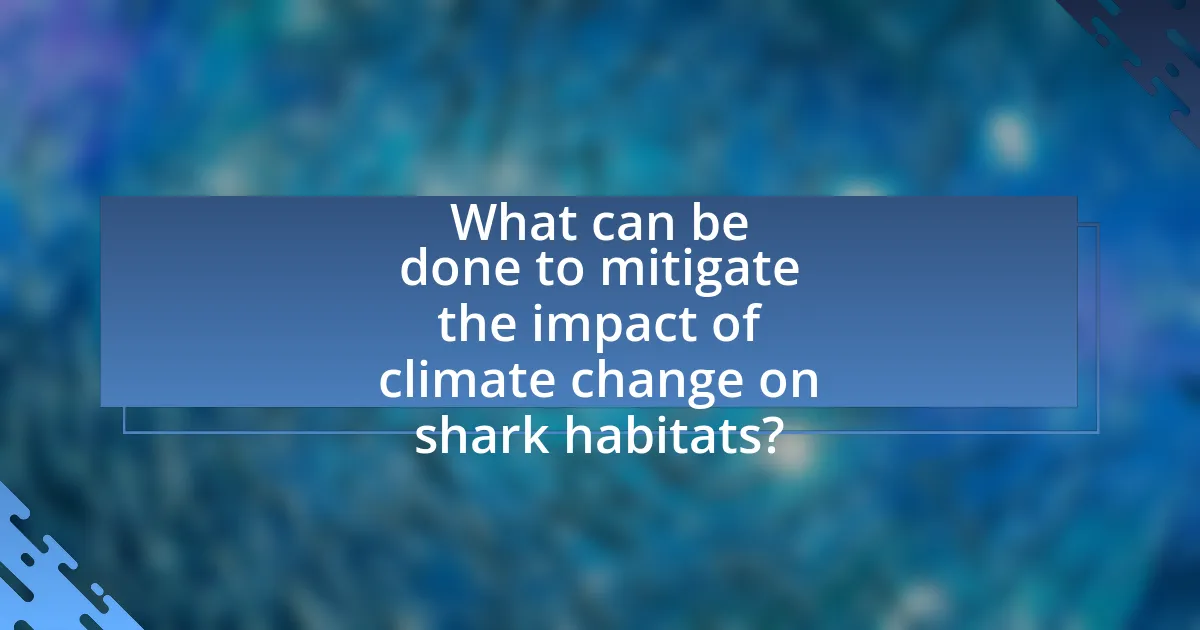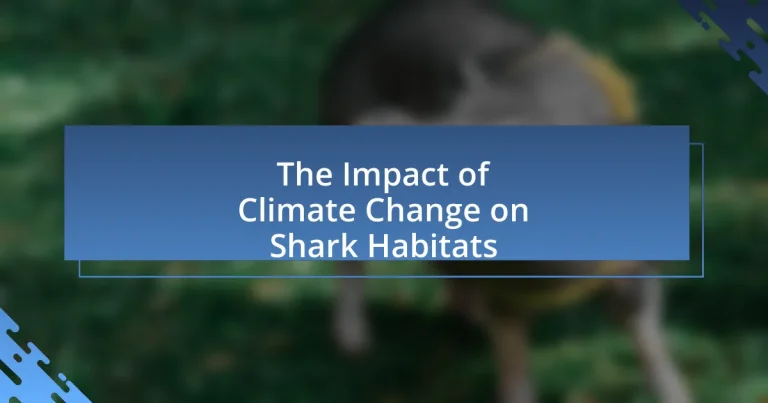The article examines the impact of climate change on shark habitats, highlighting how rising ocean temperatures, sea levels, and altered salinity levels affect shark distribution, breeding, and feeding patterns. It discusses the degradation of critical coastal ecosystems, such as coral reefs and mangroves, which serve as essential habitats for many shark species. Additionally, the article addresses the implications of changing prey availability and the physiological effects of ocean acidification on sharks. It concludes with potential conservation strategies, including the establishment of marine protected areas and sustainable fishing practices, to mitigate these impacts and protect shark populations.

What is the impact of climate change on shark habitats?
Climate change significantly alters shark habitats by affecting ocean temperatures, sea levels, and the availability of prey. Warmer waters can lead to shifts in shark distribution as they migrate to cooler areas, impacting their breeding and feeding grounds. Additionally, rising sea levels and increased ocean acidification can degrade coastal habitats like mangroves and coral reefs, which are crucial for many shark species. Research indicates that species such as the great white shark are already showing changes in their migratory patterns due to temperature fluctuations, highlighting the direct impact of climate change on their habitats.
How does climate change affect ocean temperatures and salinity?
Climate change increases ocean temperatures and alters salinity levels. Rising atmospheric temperatures lead to higher sea surface temperatures, with global ocean temperatures increasing by approximately 1.1 degrees Celsius since the late 19th century, as reported by the Intergovernmental Panel on Climate Change (IPCC). Additionally, increased evaporation rates due to warmer temperatures can result in higher salinity in some regions, while melting ice caps and glaciers contribute to lower salinity in others. This dual impact on temperature and salinity affects marine ecosystems, including shark habitats, by influencing species distribution and breeding patterns.
What are the consequences of rising ocean temperatures for shark species?
Rising ocean temperatures negatively impact shark species by altering their habitats and affecting their behavior. Warmer waters can lead to shifts in prey availability, forcing sharks to migrate to cooler areas, which may disrupt their breeding and feeding patterns. Additionally, increased temperatures can exacerbate the prevalence of diseases and parasites in sharks, further threatening their populations. Research indicates that species such as the great white shark and tiger shark are particularly vulnerable to these changes, as they rely on specific temperature ranges for optimal hunting and reproduction.
How does changing salinity impact shark habitat distribution?
Changing salinity significantly impacts shark habitat distribution by altering the availability of suitable environments for different shark species. Sharks are sensitive to salinity levels, which influence their physiological processes, reproductive success, and prey availability. For instance, species like the bull shark can tolerate a wide range of salinity, allowing them to inhabit both freshwater and marine environments, while others, such as the great white shark, prefer stable, higher salinity levels found in open ocean waters. Research indicates that shifts in salinity due to climate change, such as increased freshwater runoff from melting ice and altered precipitation patterns, can lead to habitat loss or migration of shark populations to areas with more favorable salinity conditions. This migration can disrupt local ecosystems and affect the species composition in those areas, demonstrating the critical link between salinity changes and shark habitat distribution.
What role do coral reefs play in shark habitats?
Coral reefs serve as critical habitats for sharks by providing essential shelter, breeding grounds, and abundant food sources. These ecosystems support diverse marine life, which in turn attracts various shark species that rely on the reefs for hunting and protection from larger predators. Research indicates that approximately 50% of shark species are associated with coral reef environments, highlighting their importance in maintaining shark populations. Additionally, coral reefs contribute to the overall health of marine ecosystems, which is vital for the survival of sharks and other marine species.
How is climate change affecting coral reef health?
Climate change is significantly degrading coral reef health through increased ocean temperatures and acidification. Elevated sea temperatures lead to coral bleaching, a stress response where corals expel the symbiotic algae that provide them with nutrients and color, resulting in widespread mortality. According to the Intergovernmental Panel on Climate Change (IPCC), ocean temperatures have risen by approximately 1 degree Celsius since the late 19th century, contributing to severe bleaching events. Additionally, ocean acidification, caused by increased carbon dioxide absorption, weakens coral skeletons, making them more susceptible to erosion and disease. Research published in “Nature Climate Change” by Hughes et al. (2017) indicates that these stressors threaten the biodiversity and resilience of coral ecosystems, which are crucial habitats for many marine species, including sharks.
What implications does coral reef degradation have for sharks?
Coral reef degradation significantly impacts sharks by reducing their essential habitat and prey availability. Sharks rely on coral reefs for shelter, breeding grounds, and hunting opportunities, as these ecosystems support diverse marine life. The decline of coral reefs, driven by climate change factors such as ocean warming and acidification, leads to diminished fish populations, which are crucial food sources for sharks. Research indicates that over 50% of coral reefs have been lost in the last 30 years, directly affecting the biodiversity that supports shark populations. Consequently, the degradation of these habitats threatens the survival and reproductive success of various shark species, highlighting the critical link between coral health and shark conservation.
How does climate change influence prey availability for sharks?
Climate change significantly influences prey availability for sharks by altering marine ecosystems and food webs. As ocean temperatures rise, many fish species, which are primary prey for sharks, migrate to cooler waters, often leading to a decline in local prey populations. For instance, studies have shown that species like sardines and anchovies are shifting their ranges due to temperature changes, impacting the availability of these essential food sources for sharks. Additionally, ocean acidification affects the health of coral reefs and other habitats that support prey species, further reducing their abundance. This disruption in prey availability can lead to decreased shark populations, as they rely on specific prey for survival and reproduction.
What changes in marine food webs are occurring due to climate change?
Climate change is causing significant alterations in marine food webs, primarily through rising ocean temperatures, ocean acidification, and changes in species distribution. These factors disrupt the balance of predator-prey relationships, leading to shifts in species composition and abundance. For instance, warmer waters are driving many fish species, including key prey for sharks, to migrate towards cooler areas, which can reduce food availability for sharks in their traditional habitats. Additionally, ocean acidification affects the growth and survival of shellfish, which are crucial for various marine species, further destabilizing the food web. Studies have shown that these changes can lead to decreased biodiversity and altered ecosystem dynamics, impacting the overall health of marine environments.
How do shifts in prey populations affect shark feeding behaviors?
Shifts in prey populations significantly influence shark feeding behaviors by altering their hunting strategies and locations. When prey species, such as fish or marine mammals, migrate due to changes in water temperature or availability, sharks often follow these movements to maintain access to food sources. For instance, research has shown that as ocean temperatures rise, certain fish species may move to deeper or cooler waters, prompting sharks to adapt by changing their foraging areas and techniques. A study published in the journal “Marine Ecology Progress Series” by Heithaus et al. (2016) highlights that the decline in specific prey populations can lead to increased competition among sharks, forcing them to modify their feeding habits to target alternative prey. This adaptability is crucial for their survival, demonstrating the direct link between prey availability and shark feeding behaviors.

What are the specific threats to shark habitats from climate change?
Climate change poses specific threats to shark habitats primarily through ocean warming, acidification, and habitat degradation. Ocean warming leads to shifts in shark distribution as they seek cooler waters, disrupting their breeding and feeding patterns. Acidification, resulting from increased carbon dioxide absorption, negatively affects the marine ecosystem, including prey species vital for sharks. Additionally, habitat degradation, such as coral reef loss due to rising temperatures and bleaching events, diminishes the structural complexity of environments where sharks thrive. These factors collectively threaten the survival and ecological roles of sharks in marine ecosystems.
How does ocean acidification impact shark habitats?
Ocean acidification negatively impacts shark habitats by altering the chemical composition of seawater, which can affect the availability of prey and disrupt the sensory systems of sharks. As carbon dioxide levels rise, ocean pH decreases, leading to more acidic waters that can harm the calcification processes of marine organisms, such as shellfish, which are crucial food sources for many shark species. Research indicates that changes in prey abundance and behavior due to acidification can lead to decreased foraging efficiency for sharks, ultimately affecting their survival and reproductive success.
What are the effects of acidification on shark physiology?
Acidification negatively affects shark physiology by altering their sensory systems, reducing their ability to detect prey and avoid predators. Research indicates that increased carbon dioxide levels lead to lower pH in ocean waters, which can impair the function of the olfactory system in sharks, crucial for their survival. A study by Heupel et al. (2019) published in the journal “Marine Biology” found that acidified conditions significantly hindered the ability of juvenile sharks to sense chemical cues in their environment, impacting their foraging efficiency and predator avoidance. This physiological change can have cascading effects on shark populations and marine ecosystems.
How does ocean acidification affect the ecosystems that support sharks?
Ocean acidification negatively impacts the ecosystems that support sharks by altering the availability of prey and disrupting the overall health of marine habitats. As carbon dioxide levels increase, ocean waters absorb more CO2, leading to a decrease in pH levels, which affects calcifying organisms such as corals and shellfish that are crucial for the marine food web. For instance, studies show that coral reefs, which provide essential habitats for many shark prey species, are declining due to acidification, with projections indicating a potential loss of up to 70% of coral reefs by 2050 if current trends continue. This decline in coral ecosystems reduces biodiversity and the abundance of fish species that sharks rely on for food, ultimately threatening shark populations and their ecological roles.
What are the impacts of sea level rise on coastal shark habitats?
Sea level rise negatively impacts coastal shark habitats by altering their breeding and feeding grounds. As sea levels increase, essential habitats such as mangroves and seagrass beds may become submerged or degraded, reducing the availability of nursery areas for juvenile sharks. Research indicates that a rise of just one meter in sea level can lead to significant habitat loss, affecting species like the blacktip reef shark, which relies on shallow coastal waters for reproduction. Additionally, increased salinity and changes in water temperature due to sea level rise can disrupt the ecological balance, further threatening shark populations and their prey availability.
How does habitat loss due to sea level rise affect shark populations?
Habitat loss due to sea level rise negatively affects shark populations by reducing their breeding and nursery grounds. As coastal habitats like mangroves and seagrasses are submerged, essential areas for juvenile sharks to grow and develop are diminished. Research indicates that these habitats are critical for the survival of many shark species, as they provide shelter from predators and abundant food sources. For instance, a study published in the journal “Marine Ecology Progress Series” highlights that the loss of these habitats can lead to decreased recruitment rates in shark populations, ultimately threatening their long-term viability.
What adaptations might sharks need to survive in changing coastal environments?
Sharks may need physiological adaptations such as altered metabolic rates and enhanced osmoregulation to survive in changing coastal environments. As coastal waters warm due to climate change, sharks could require increased metabolic efficiency to cope with higher temperatures, which can affect their growth and reproduction. Additionally, changes in salinity from freshwater influx due to melting ice or increased rainfall may necessitate improved osmoregulatory mechanisms to maintain internal salt balance. Research indicates that species like the bull shark can tolerate a wide range of salinities, showcasing an existing adaptability that may be crucial as coastal environments continue to change.
How does climate change lead to increased frequency of extreme weather events?
Climate change leads to increased frequency of extreme weather events primarily through the rise in global temperatures, which intensifies atmospheric conditions. As the Earth’s temperature increases, it causes more evaporation of water, resulting in higher humidity levels. This heightened humidity contributes to the formation of more intense storms, such as hurricanes and heavy rainfall events. According to the Intergovernmental Panel on Climate Change (IPCC), the frequency of extreme weather events has increased significantly, with a notable rise in the intensity and duration of heatwaves and heavy precipitation since the late 20th century. These changes disrupt ecosystems, including shark habitats, by altering ocean temperatures and salinity, further impacting marine biodiversity.
What are the potential impacts of storms and flooding on shark habitats?
Storms and flooding can significantly disrupt shark habitats by altering water quality, changing salinity levels, and destroying essential coastal ecosystems. These environmental changes can lead to decreased prey availability and increased stress on shark populations. For instance, heavy rainfall from storms can introduce pollutants and sediments into coastal waters, negatively affecting the health of marine life and the overall ecosystem. Additionally, flooding can lead to habitat loss, particularly in areas like mangroves and seagrass beds, which are crucial for shark breeding and nursery grounds. Studies have shown that such habitat degradation can result in reduced shark populations and biodiversity, impacting the ecological balance of marine environments.
How do extreme weather events disrupt shark migration patterns?
Extreme weather events disrupt shark migration patterns by altering ocean temperatures, salinity, and currents. These changes can lead to shifts in prey availability and habitat suitability, forcing sharks to adapt their migratory routes. For instance, hurricanes can create significant changes in water temperature and salinity, which can displace prey species and affect the sharks’ feeding grounds. Research indicates that increased storm frequency and intensity, linked to climate change, can lead to more unpredictable migration patterns, as sharks may be forced to seek alternative routes to find food and suitable breeding grounds.

What can be done to mitigate the impact of climate change on shark habitats?
To mitigate the impact of climate change on shark habitats, effective strategies include establishing marine protected areas (MPAs) and implementing sustainable fishing practices. MPAs can help preserve critical habitats and allow ecosystems to recover from stressors, as evidenced by studies showing that protected areas can enhance biodiversity and resilience in marine environments. Additionally, sustainable fishing practices reduce overfishing and bycatch, which are significant threats to shark populations. Research indicates that regions with regulated fishing show healthier shark populations, contributing to ecosystem stability.
What conservation strategies are effective in protecting shark habitats?
Effective conservation strategies for protecting shark habitats include the establishment of marine protected areas (MPAs), sustainable fishing practices, and habitat restoration initiatives. Marine protected areas restrict human activities that can harm shark populations and their environments, leading to healthier ecosystems. Research indicates that MPAs can increase shark populations by up to 50% within five years of establishment, as shown in a study published in the journal “Marine Ecology Progress Series.” Sustainable fishing practices, such as catch limits and gear modifications, help reduce bycatch and ensure that shark populations remain stable. Additionally, habitat restoration initiatives, like coral reef rehabilitation, enhance the natural environments that sharks rely on for breeding and feeding. These strategies collectively contribute to the long-term protection of shark habitats against the impacts of climate change.
How can marine protected areas help mitigate climate change effects on sharks?
Marine protected areas (MPAs) can mitigate climate change effects on sharks by providing safe habitats that enhance their resilience to environmental stressors. MPAs help maintain biodiversity and ecosystem health, which are crucial for sharks’ survival as they face challenges such as ocean warming and acidification. Research indicates that MPAs can improve the abundance and diversity of marine species, including sharks, by reducing human impacts like overfishing and habitat destruction. For instance, a study published in “Nature” by Edgar et al. (2014) found that MPAs can lead to a 446% increase in shark populations compared to unprotected areas, demonstrating their effectiveness in fostering healthier marine ecosystems that can better withstand climate change.
What role do sustainable fishing practices play in shark conservation?
Sustainable fishing practices are crucial for shark conservation as they help maintain healthy shark populations and ecosystems. By implementing measures such as catch limits, gear restrictions, and protected areas, sustainable fishing reduces bycatch and habitat destruction, which are significant threats to sharks. For instance, the International Union for Conservation of Nature (IUCN) reports that overfishing has led to declines in shark populations by up to 90% in some regions. Therefore, sustainable fishing not only protects sharks directly but also supports the overall marine biodiversity that is essential for their survival.
How can public awareness and education contribute to shark habitat protection?
Public awareness and education significantly contribute to shark habitat protection by fostering informed communities that advocate for conservation efforts. When individuals understand the ecological importance of sharks and their habitats, they are more likely to support policies and initiatives aimed at protecting these environments. For instance, educational programs that highlight the role of sharks in maintaining marine ecosystems can lead to increased public support for marine protected areas. Research indicates that communities engaged in conservation education are more likely to participate in sustainable practices, as seen in initiatives like the Shark Trust’s educational outreach, which has successfully raised awareness and led to policy changes in various regions.
What initiatives exist to educate communities about the importance of sharks?
Initiatives that educate communities about the importance of sharks include programs like Shark Savers, which focuses on raising awareness through community outreach and educational workshops. These initiatives aim to inform the public about the ecological role of sharks in marine ecosystems, emphasizing their importance in maintaining the balance of ocean health. For instance, studies show that healthy shark populations contribute to the stability of coral reefs and the overall biodiversity of marine environments. Additionally, organizations like Oceana and the Shark Research Institute conduct educational campaigns that highlight the threats sharks face from climate change and overfishing, further reinforcing the need for conservation efforts.
How can individuals contribute to the conservation of shark habitats?
Individuals can contribute to the conservation of shark habitats by supporting sustainable fishing practices and reducing plastic pollution. Sustainable fishing helps maintain healthy shark populations and their ecosystems, while reducing plastic waste prevents habitat degradation and protects marine life. According to the Food and Agriculture Organization, overfishing and habitat destruction are significant threats to sharks, making individual actions crucial in promoting sustainable practices. Additionally, participating in beach clean-ups and advocating for policies that protect marine environments further enhances the conservation of shark habitats.
What are the best practices for researchers studying the impact of climate change on sharks?
The best practices for researchers studying the impact of climate change on sharks include utilizing long-term ecological monitoring, employing advanced tracking technologies, and conducting interdisciplinary studies. Long-term ecological monitoring allows researchers to gather data on shark populations and their habitats over time, which is essential for understanding trends related to climate change. Advanced tracking technologies, such as satellite and acoustic tagging, enable researchers to study shark movements and behaviors in response to changing environmental conditions. Interdisciplinary studies that incorporate oceanography, marine biology, and climate science provide a comprehensive understanding of how climate change affects shark habitats. These practices are supported by findings from studies like “Climate Change and Sharks: Impacts on Distribution and Abundance” published in Marine Ecology Progress Series, which highlights the importance of integrated approaches in marine research.


